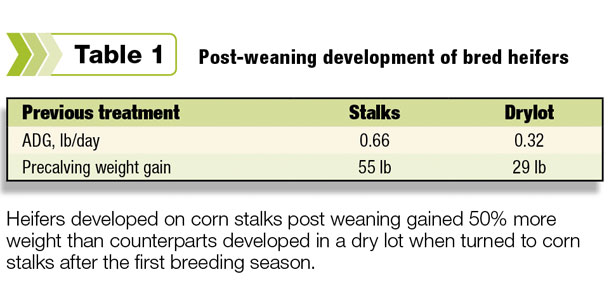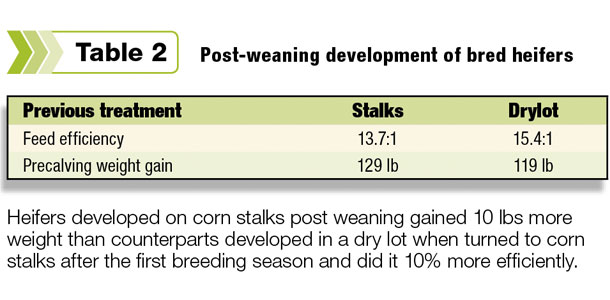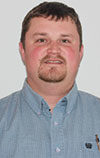For a review, I refer readers to previous issues of my company’s newsletter (May/June 2009; available at Great Plains Livestock Consulting Inc.) and numerous beef reports (available at UNL Beef). In this article, I want to discuss the practical application of development strategies and what this means from an economic standpoint.
The premise for contemporary heifer development is that heifers do not need to reach 65 percent of their mature weight by first breeding. Rather, a slightly lower percentage is adequate and, one may argue, more appropriate.
I must also preface the article by stating that I do not expect 100 percent of heifers to become pregnant. An 80 percent pregnancy rate is a more realistic target and likely means you have induced the right amount of stress to sort out the reproductively inefficient females.
Having said that, first-service conception rate is still extremely important, and a progesterone-based synchronization program (MGA or CIDR) will help ensure the reproductively sound heifers breed up early.
The research on target weight and pregnancy rate is clear. However, the focus of this article is the intrinsic benefits of training a virgin heifer to be a cow.
A small body of very interesting research has provided evidence that heifers clearly learn how to graze stockpiled forages, corn stalks or winter pasture after weaning, making them substantially more capable to utilize low-quality forages as a bred female.

Research conducted by Dr. Rick Funston and co-workers at the University of Nebraska has demonstrated that post-weaning development alters how bred heifers respond to grazing low-quality forage.
This adaptation is not only psychological but also physiological. The same body of research generated the following results proving a physiological effect of heifer development. Though the metabolic pathway is not yet fully understood, post-weaning heifer development creates a lasting impact on feed efficiency in the bred heifer.
Additional research from Dr. Funston also suggest that cattle may learn how to graze stockpiled forages more rapidly if “trained” by an experienced animal. To this end, we recommend that if you routinely graze corn stalks or dormant grass during the winter, use your mature cows to train the virgin heifers.

This can be easily accomplished by weaning the heifer calves for a period of 20 to 30 days and simply turning them back out with their dams after they are sufficiently weaned.
If winter grazing is not an option, the data clearly indicates that lower-energy heifer development will make a more efficient cow herd. This includes not only feed efficiency but also reproductive efficiency, as indicated by data from both the University of Nebraska and the USDA station in Miles City, Montana.
A program for your region
Heifer development programs will vary widely across the country depending on forage resources available post-weaning. It is imperative to keep the big picture in mind when designing a heifer development program. The goal must be to maintain a moderately increasing plane of nutrition all the way onto pasture.
The most common failing of many development plans is the plane of nutrition prior to turnout is so high, the transition to grass is actually a reduction in nutrient intake.
Keep in mind, a modest increase in total nutrition provision prior to breeding will help initiate puberty and work in conjunction with your synchronization program. However, this must correlate with your pasture resources. Work with your nutritionist to design a program that best fits your spring pasture.
The take-home messages from this article are:
1. Develop a heifer as similarly as possible to how she will be maintained as a stock cow; doing so will allow her to make the transition to a stock cow program seamlessly.
2. Take advantage of both the psychological and physiological benefits of heifer development to make the most efficient cow herd possible.
3. Manage the development program with the transition from breeding to spring pasture in mind; doing so will limit both reproductive failure and body condition loss after turnout.
Stress heifers sufficiently to ensure reproductively inefficient heifers are culled from the herd prior to the first calving season.
This is perhaps a paradigm shift for many cattlemen. As any good cattle stewards, we like all ages of cattle to look as smooth and uniform as possible.
However, the main purpose of a well-designed heifer development protocol should be to stress the heifers sufficiently to cull out the feed and reproductively inefficient animals before they enter the cow herd.
The key factors of such a system are that we have put relatively little money into the heifers prior to breeding, and that they will remain a body condition conducive to entering the feedlot as a long yearling after pregnancy diagnosis in the fall if they are open.
Please visit with your nutritionist to design a program that best fits your feed resources, environment and cow herd goals. ![]()

- Dan Larson
- Great Plains Livestock Consulting Inc.







